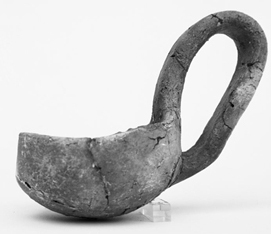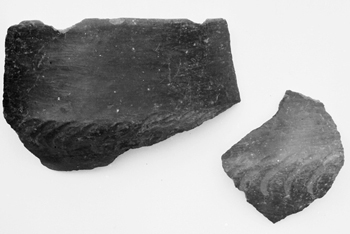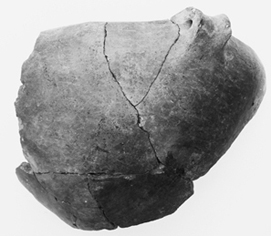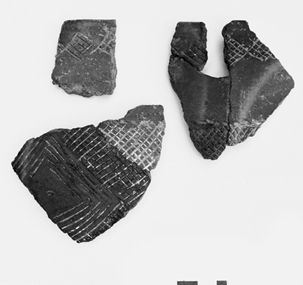bronze Age : vessels
CERAMIC VESSELS OF THE EARLY BRONZE AGE
Unlike in the Neolithic, there is no evidence during this period at Dikili Tash for any stone vessels or vessels from raw clay (which may have existed, of course, but were not preserved). Pottery shows strong signs of change. The replacement of painted decoration by incised and impressed decoration is combined with a change in the patterns and in the way they are organized.
Likewise, new vessel shapes appear.

 The most characteristic shapes of the first phase of the Early Bronze Age are the cups with raised handles (scoops), sometimes decorated with impressions, and the cups with sinuous walls and grooved decoration on their shoulders. Bowls with incurved rims and two trumpet-like handles, or with simple lugs perforated vertically or horizontally, are often found in both phases; they are usually undecorated. There are also conical plates and basins with simple flat or thickened rims, which are decorated with impressions or incisions either on the rim or on the whole inner surface. Bowls with upright walls and shouldered bowls with outverted rims, typical of the Early Bronze Age II, bear impressed or incised decoration organized in horizontal bands or frames. The patterns are now rectilinear (vs. the meanders and spirals of the Neolithic), the organization is tighter, and incisions are shallower. With regard to closed vessels, we see the emergence of jugs with cut-away necks. Jars, whose numbers seem to increase towards the end of the period, often have applied coils with finger impressions or notches (a decoration already known from the Neolithic, that will last until the end of the Bronze Age, or simple rows of short incisions or impressions made with a sharp tool.
The most characteristic shapes of the first phase of the Early Bronze Age are the cups with raised handles (scoops), sometimes decorated with impressions, and the cups with sinuous walls and grooved decoration on their shoulders. Bowls with incurved rims and two trumpet-like handles, or with simple lugs perforated vertically or horizontally, are often found in both phases; they are usually undecorated. There are also conical plates and basins with simple flat or thickened rims, which are decorated with impressions or incisions either on the rim or on the whole inner surface. Bowls with upright walls and shouldered bowls with outverted rims, typical of the Early Bronze Age II, bear impressed or incised decoration organized in horizontal bands or frames. The patterns are now rectilinear (vs. the meanders and spirals of the Neolithic), the organization is tighter, and incisions are shallower. With regard to closed vessels, we see the emergence of jugs with cut-away necks. Jars, whose numbers seem to increase towards the end of the period, often have applied coils with finger impressions or notches (a decoration already known from the Neolithic, that will last until the end of the Bronze Age, or simple rows of short incisions or impressions made with a sharp tool.

 Changes are not limited to morphological elements. They affect the entire sequence of pottery production. The number and variety of the clay sources used are seriously reduced. The great majority of vessels are now manufactured with clays taken from the sedimentary deposits of the Philippi marsh. Burnishing is heavier and more rapidly executed, while the firing of pottery is made at temperatures below 850-900 ºC. Finally, the use of crushed bones as a material for the white filling of the incised and impressed decoration is an entirely new trend that replaces the calcite used for the same purpose during the Neolithic.
Changes are not limited to morphological elements. They affect the entire sequence of pottery production. The number and variety of the clay sources used are seriously reduced. The great majority of vessels are now manufactured with clays taken from the sedimentary deposits of the Philippi marsh. Burnishing is heavier and more rapidly executed, while the firing of pottery is made at temperatures below 850-900 ºC. Finally, the use of crushed bones as a material for the white filling of the incised and impressed decoration is an entirely new trend that replaces the calcite used for the same purpose during the Neolithic.

